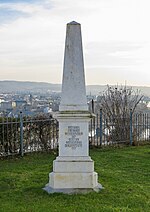Villa Weißhaus
The Villa Weißhaus is a classical building in Trier .
predecessor
A smaller hut, called the Weißhäuschen, probably came from the 17th century and initially belonged to the municipality of Pallien . In 1773 it became the property of the city of Trier and was leased. When Lord Mayor Wilhelm von Haw acquired the Weisshaus, Ottoscheuer and Mergener Grünhäuschen and designed a coherent complex from it, the Weisshäuschen was demolished. In 1823 it was replaced by the villa that still exists today .
The construction
The Villa Weißhaus was built in 1823 like the associated economic building Drachenhaus (1829) in the style of Prussian classicism on a sandstone rock above the suburb of Pallien. Only on the city side was the three-axis facade designed more elaborately. The villa is about twelve meters long and seven meters wide; Because of the hillside location, the prestigious facade is three-story, the rest two-story.
The basement is divided by three arched doors with skylight lunettes , of which the middle one is walled up and only represents a niche. A simple strip of cornice runs between the lower and ground floor. The three tall rectangular windows on the first floor correspond to the doors of the basement, above which there is a windowsill cornice. The central axis is slightly emphasized on these two lower floors. As she emerges something in the basement and ground floor, it is in the main floor back slightly.
On this floor there is a balcony with a wrought iron grille in front of the central axis. It is supported by four consoles on pine cones. These consoles are laterally with flower wreath motifs on the front with fluting decorated and flower sculptures. Behind the balcony there are four pilasters with stylized leaf capitals and a semicircular lintel. Floral motifs can be seen above the central window. This arrangement simulates a Serliana . There is another strip of cornice above the side window.
The villa has a flat hipped roof with small dormers.
Use of the Villa Weißhaus
The mansion served as the private residence of the Lord Mayor of Haw, while the site was open to city residents for use and recreation. After von Haw's death, the property including the villa was bought by Prince Heinrich of the Netherlands . This new owner also had the site publicly used, but was planning another villa. However, since Prince Heinrich died a few years later, this was not built. In 1879, citizens of Trier founded the Weißhaus-Verein stock corporation in order to preserve the recreational area for the townspeople and to prevent it from being taken over by a private buyer. Kaiser Wilhelm I personally bought ten shares worth 100 marks each; The project was difficult to finance, but eventually succeeded. After new paths to the villa and a garden terrace had been laid out as well as numerous renovations, the villa was leased as a restaurant in 1881. In 1901 a glass hall was added. During the First World War it served as a convalescent home for the German Red Cross ; In 1919 it became the property of the city along with the site.
After the Second World War , the building was in danger of falling into disrepair as there was no longer any tenant. The fact that the Trier gondola lift (dismantled in 2011) was built during this time turned out to be beneficial, as the property was more easily accessible from the city. The city of Trier was considering building a holiday complex with around 100 apartments on the adjacent site in order to finance the renovation of the White House from the proceeds. A citizens' initiative that collected around 13,000 signatures arose against these plans. As a result, a building owners' association Weißhaus was founded, consisting of private individuals and the city of Trier, which brought together the necessary financial means for a renovation. The building was renovated and an annex was added - the old glass hall no longer existed. In the meantime (as of May 2015) the site is completely owned by the city of Trier again, the catering business was closed after the lease contract expired at the end of 2014, but should be resumed after the building was renovated. At the beginning of 2017 this project became more concrete, the city of Trier conducted concrete negotiations with two investors. First of all, a test season should be carried out with the future tenant to check its reliability. The extension of the restaurant to include a hotel, as proposed by one of the possible tenants, would have to be based on the requirements of the monument and landscape protection.
White house fountain and obelisk
The Weißhausbrunnen, which dates from the time the villa was built, has also been preserved on the site. In the 1950s, consideration was given to putting it back into operation, but the destroyed water pipes were not replaced.
The Weißhaus obelisk, which was erected by the Weißhaus Association in 1879 and was temporarily lost, is now in the immediate vicinity of the Weißhaus Villa.
literature
- Ahlhelm, Morgen, Simon, Tietzen: Do you remember? Trier restaurants yesterday and today. Volume V. Trier 2009, pp. 14/15.
Web links
- Entry for Villa Weißhaus in the database of cultural assets in the Trier region .
Individual evidence
- ↑ Eric Thielen: Trier Weißhaus closes at the end of the year. In: Trier Reporter. December 15, 2014, accessed February 23, 2016 .
- ↑ http://www.trier-reporter.de/weisshaus-lichter-oder-schroeder/
- ↑ entry to Weßhaus obelisk in the database of cultural assets in the Trier region ; accessed on February 23, 2016.
Coordinates: 49 ° 46 '7.4 " N , 6 ° 38' 2.7" E






